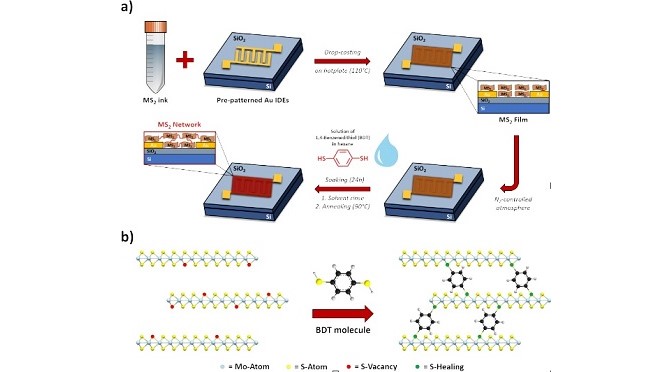Researchers from the University of Strasbourg & CNRS (France), in collaboration with Trinity College Dublin (Ireland) and the University of Cambridge (United Kingdom), have devised a new molecular strategy to boost the performance of electronic devices based on semiconducting 2D materials. These results have been published in Nature Nanotechnology.
Within the ever-growing family of two-dimensional (2D) semiconductors, transition metal dichalcogenides (TMDs) – noted as MX2 and consisting of an atomic layer of transition metal atoms (M = Mo, W, Re, Pt, etc.) sandwiched between two atomic layers of chalcogen atoms (X = S, Se, Te) – occupy a prominent place and offer a wide-ranging portfolio of electronic, optical and mechanical properties.
2D TMDs can be as obtained as colloidal dispersions by liquid-phase exfoliation of bulk crystals in specific solvents. This process allows the large-scale production of highly concentrated TMD inks, although it suffers from the formation of structural defects that are detrimental to the materials’ performance in (opto)electronics.
The researchers from Strasbourg, Dublin and Cambridge have made a huge step forward by developing a molecular functionalization strategy to overcome these limitations. The idea is simple yet effective: using small molecules to simultaneously “heal” the material’s defects generated upon exfoliation and bridge neighboring flakes. In this way, the TMD crystal structure is restored and the charge transport across the covalently interconnected network is improved, leading to electronic devices (e.g. thin-film transistors) with superior electrical performance, water stability and mechanical robustness.
This universal approach represents a major breakthrough, and it holds a great potential for applications in printed, flexible and wearable (opto)electronics, (bio)sensing as well as (photo)catalysis.
Covalently interconnected transition metal dichalcogenide networks via defect engineering for high-performance electronic devices
Stefano Ippolito, Adam G. Kelly, Rafael Furlan de Oliveira, Marc-Antoine Stoeckel, Daniel Iglesias, Ahin Roy, Clive Downing, Zan Bian, Lucia Lombardi, Yarjan Abdul Samad, Valeria Nicolosi, Andrea C. Ferrari, Jonathan N. Coleman & Paolo Samorì*
Nature Nanotechnology (2021), DOI: 10.1038/s41565-021-00857-9

